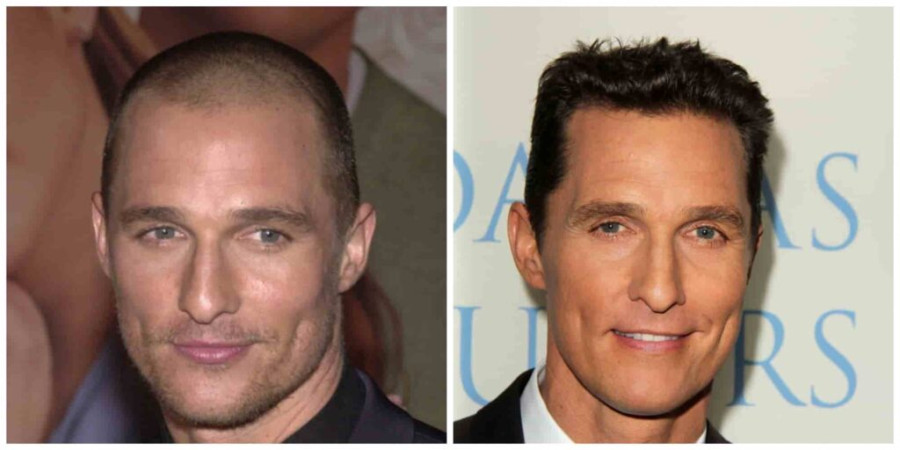

Matthew McConaughey's Hair Transformation: How Did He Get It Back?
Remember Matthew McConaughey in the early 2000s? His floppy blonde hair was practically a trademark. But then, something changed. By the late 2000s, his hairline seemed to be receding, and rumors of hair loss swirled. Fast forward to today, and McConaughey's sporting a full head of thick hair once again. So, what happened? Did he find the holy grail of hair loss solutions? Let's explore the possibilities.
The Great Disappearing Hairline
McConaughey's noticeable hair loss wasn't uncommon. Male pattern baldness, also known as androgenetic alopecia, affects a significant portion of men. It's caused by a combination of genetics and hormones, and while there's no permanent cure, there are treatments available.
Did McConaughey Get a Hair Transplant?
Many speculate that McConaughey underwent a hair transplant. Hair transplants involve surgically removing hair follicles from a donor area on the scalp and transplanting them to balding areas. While McConaughey himself hasn't confirmed this, several hair transplant surgeons have weighed in, analyzing photos and suggesting a possible transplant (https://www.smilehairclinic.com/en/). However, these are just educated guesses, not medical confirmations.
McConaughey's Own Hair Regrowth Story
The most intriguing aspect of McConaughey's hair story is his own account. In interviews, he's remained tight-lipped about specific treatments but claims he "fully committed" to applying a topical ointment "once a day for 10 minutes" for hair regrowth (https://people.com/style/matthew-mcconaughey-on-regrowing-his-hair-after-nearly-losing-it/). He hasn't revealed the product's name, but his dedication suggests he believes in its effectiveness.
The Bottom Line: Limited Answers, But Hope for Some
The truth behind McConaughey's hair transformation remains a bit of a mystery. Hair transplants are a possibility, but his claim of topical treatment success offers a glimmer of hope for those experiencing hair loss. It's important to remember that individual results will vary, and consulting with a qualified dermatologist or hair loss specialist is crucial before starting any treatment.
The Takeaway: There May Be Options
While we may never know the exact details of McConaughey's hair journey, it does highlight that there are options available for men experiencing hair loss. Whether it's exploring hair transplants, consulting with a professional about medication, or trying various hair growth products, there are ways to address thinning hair and potentially achieve a fuller head of hair.
Beyond McConaughey: Exploring Hair Loss Solutions
Matthew McConaughey's hair transformation has undoubtedly sparked interest and curiosity among those facing hair loss. While his specific approach remains somewhat elusive, his story underscores the fact that hair loss is a common concern and that there are potential avenues to address it.
Delving Deeper into Hair Loss Solutions
-
Hair Transplants: Hair transplants involve surgically transferring hair follicles from a donor area to thinning or balding areas. They are a permanent solution for hair loss in the transplanted areas, but they can be costly and may require multiple procedures.
-
Minoxidil and Finasteride: These are FDA-approved medications for male pattern baldness. Minoxidil (Rogaine) is a topical solution that promotes hair growth, while finasteride (Propecia) is an oral medication that blocks dihydrotestosterone (DHT), a hormone that contributes to hair loss. Both medications require ongoing use to maintain results, and they may have side effects.
-
Low-Level Laser Therapy (LLLT): LLLT involvesusing low-level lasers or LEDs to stimulate hair growth. Studies have shown mixed results, with some suggesting potential benefits in slowing hair loss and promoting regrowth. More research is needed to determine its long-term efficacy.
-
Lifestyle Changes: While not a direct treatment for hair loss, maintaining a healthy lifestyle can support overall scalp health and potentially contribute to hair growth. This includes a balanced diet, adequate sleep, stress management, and avoiding smoking.
Seeking Professional Guidance
Consulting with a dermatologist or hair loss specialist is crucial for personalized advice and treatment options. They can assess your hair loss pattern, underlying causes, and medical history to recommend the most appropriate approach.
Remember, everyone's hair loss journey is unique, and what works for one person may not be suitable for another. It's essential to approach hair loss with realistic expectations and explore options with the guidance of a qualified healthcare professional.
References
- https://www.aad.org/public/diseases/hair-loss
- https://www.mayoclinic.org/drugs./minoxidil./drg-20068750?p=1
- https://www.webmd.com/drugs/2/drug-1548-9167/finasteride-oral/finasteride-hair-growth-oral/details
- https://www.healthline.com/health/laser-treatment-for-hair-loss
Popular articles

Apr 11, 2024 07:40 PM

May 25, 2024 08:09 PM

Apr 11, 2024 07:22 PM

Apr 10, 2024 07:59 PM

Mar 14, 2024 07:53 PM
Comments (0)